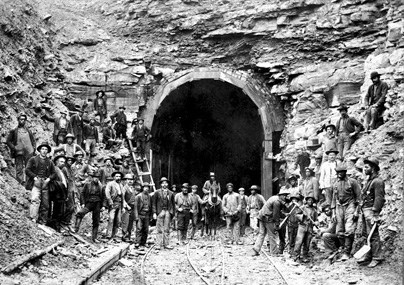
NPS photo/Dave Bieri
In the early 1870s, construction of the Chesapeake and Ohio Railway along the Greenbrier and New Rivers employed thousands of workers. Many of these men were African Americans who migrated to West Virginia in search of jobs. Jobs on the railroad were labor intensive and low paying, required long hours, and were at times dangerous. Railroad workers primarily used shovels, wheelbarrows, mules, and black powder to move millions of tons of rock and dirt to prepare the railroad bed. Workers used axe and adz to cut and shape hundreds of trees into ties, bridge timbers, and lumber for railcars. They sweated in the hot summer sun and froze in the cold mountain winters as they worked to connect Tidewater Virginia with the Ohio River Valley. As the C&O Railway stretched westward along the Greenbrier River, The Legend of John Henry was born at Big Bend Mountain near Talcott, West Virginia. The Legend of John Henry is just that, a “legend,” and through the legend, John Henry became a symbol. He symbolized the many African Americans whose sweat and hard work built and maintained the rails across West Virginia. He was a symbol for the black workers who gave their lives in these dangerous occupations. The legend, as told through ballads and work songs, has kept the story of John Henry and the black railroad workers alive. In February of 1870, workers began drilling the Great Bend Tunnel where the Greenbrier River makes a seven-mile meander around Big Bend Mountain. Over 800 men, many of them African American, cut a 6,450 foot-long tunnel through the mountain. The workers cut through layers of red shale, which tended to disintegrate when exposed to air, making the tunnel a dangerous place to work. Rock falls were common and death was always a possibility. At nearly a mile and one quarter long, the Great Bend Tunnel is the longest on the C&O Railway. 
As the story goes, John Henry was hired as a steel driver for the railroad. Later, the railroad company brought in a steam drill to speed up work on the tunnel. It was said that the steam drill could drill faster than any man. The challenge was on, “man against machine.” John Henry was known as the strongest, the fastest, and the most powerful man working on the railroad. He went up against the steam drill to prove that the black worker could drill a hole through the rock farther and faster than the drill could. Using two 10-pound hammers, one in each hand, he pounded the drill so fast and so hard that he drilled a 14-foot hole into the rock. The legend says that the drill was only able to drill nine feet. John Henry beat the steam drill and later died of exhaustion. The Great Bend Tunnel was completed on September 12, 1872, and remained in service until 1974. The tunnel and the man have been cemented into the annals of time through The Ballad of John Henry. The song tells of a boy born with a "hammer in his hand.” It tells of a man who worked as a steel driver during the construction of the Great Bend Tunnel. It tells us that this man took a hammer in each hand to face down a steam-powered drilling machine. John Henry promised, "If I can't beat this steam drill down, I'll die with this hammer in my hand!" At the Great Bend Tunnel, John Henry became one of the world’s great folk heroes. Sources Turner, Charles W., et al. Chessie's Road. Alderson: C&O Historical Society, 1986. Dixon, Thomas W. Jr. Chesapeake & Ohio Alleghany Subdivision. Alderson: C&O Historical Society, 1985. Lane, Ron "Great Bend Tunnel." e-WV: The West Virginia Encyclopedia. 13 February 2012. Web. 20 July 2016. Hampel, Carlene, The Man - Facts, Fiction and Themes, 1998 |
An official website of the United States government
Here's how you know
Official websites use .gov
A
.gov website belongs to an official government
organization in the United States.
Secure .gov websites use HTTPS
A
lock (
) or https:// means you've safely connected to
the .gov website. Share sensitive information only on official,
secure websites.
